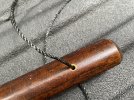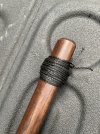I’ve heard conflicting opinions on this. Some say never use a lanyard on a hawk when chopping for example because if you lose control, the hawk will swing back and cut you potentially. On the other hand, using a lanyard on a big knife to chop seems quite common and doesn’t seem all that different than a hawk. The chopping motion seems about the same, with the potential benefits and risks seemingly in line. Is the shape of the hawk versus the knife a factor in making a lanyard on the hawk an no-no? Opinions?
-
The BladeForums.com 2024 Traditional Knife is ready to order! See this thread for details: https://www.bladeforums.com/threads/bladeforums-2024-traditional-knife.2003187/
Price is$300$250 ea (shipped within CONUS). If you live outside the US, I will contact you after your order for extra shipping charges.
Order here: https://www.bladeforums.com/help/2024-traditional/ - Order as many as you like, we have plenty.
You are using an out of date browser. It may not display this or other websites correctly.
You should upgrade or use an alternative browser.
You should upgrade or use an alternative browser.
Does a lanyard make sense on a tomahawk?
- Thread starter rlewpolar
- Start date
gentleman_edc
Basic Member
- Joined
- Sep 19, 2021
- Messages
- 655
If it was good enough for Thor, it is good enough for me.
Bigburly912
Gold Member
- Joined
- Nov 14, 2018
- Messages
- 420
Ive used a lanyard on hawks before but I use a long lanyard twist it and run it up with the handle. I hope that makes sense. I would never leave it free hanging off my wrist.
bikerector
Knifemaker / Craftsman / Service Provider
- Joined
- Nov 16, 2016
- Messages
- 6,791
I don't like lanyards for hawks, machetes, or choppers. I would prefer to throw the knife or axe if it slips that badly, but rarely is that actually a problem, and never with a tool that isn't new to me. I will do grip tape long before a lanyard, these days.
I used to like a lanyard for choking way off the back or a knife, but it always seemed to get in the way when not using the lanyard, for just general cutting stuff, or knocked around to the point of being more nuisance that utility, IME. Also, when it did catch a knife that slipped, I didn't like it attached to me while it swung around to a stop. I now just prefer handles with better retention, even at the expense of comfort. Large pinky hooks are uncomfortable for me, but really limit a knife from sliding completely out of your hand.
If I had one on a hawk, chopper, or machete, it would be very short, only enough for a single finger and for hanging on a hook.
I used to like a lanyard for choking way off the back or a knife, but it always seemed to get in the way when not using the lanyard, for just general cutting stuff, or knocked around to the point of being more nuisance that utility, IME. Also, when it did catch a knife that slipped, I didn't like it attached to me while it swung around to a stop. I now just prefer handles with better retention, even at the expense of comfort. Large pinky hooks are uncomfortable for me, but really limit a knife from sliding completely out of your hand.
If I had one on a hawk, chopper, or machete, it would be very short, only enough for a single finger and for hanging on a hook.
DocJD
Basic Member
- Joined
- Jan 29, 2016
- Messages
- 12,053
For anything I intend to be able to throw , I definitely don't want a lanyard interfering .lanyard on the hawk an no-no? Opinions?
Other than that , depends on individual use and preference .
- Joined
- Mar 8, 2008
- Messages
- 26,079
As a general rule, no, they're more a liability than they are a help. Chiefly because good chopping technique with one-handed choppers necessitates a certain rolling snap of the fingers and wrist, which a properly used lanyard interferes with. When used right, a lanyard hangs off the back of the thumb and wraps around into the hand snugly, locking the tool to the hand. Dropping the tool in this state causes it to swing across the body instead of back towards it, which is much much safer. However, it also locks the wrist. While there are some niche circumstances where a lanyard is legitimately of assistance, I generally find them to be poor practice.
DocJD
Basic Member
- Joined
- Jan 29, 2016
- Messages
- 12,053
Are hawks being commonly used now for utility , chopping wood ?As a general rule, no, they're more a liability than they are a help. Chiefly because good chopping technique with one-handed choppers necessitates a certain rolling snap of the fingers and wrist, which a properly used lanyard interferes with. When used right, a lanyard hangs off the back of the thumb and wraps around into the hand snugly, locking the tool to the hand. Dropping the tool in this state causes it to swing across the body instead of back towards it, which is much much safer. However, it also locks the wrist. While there are some niche circumstances where a lanyard is legitimately of assistance, I generally find them to be poor practice.
- Joined
- Mar 8, 2008
- Messages
- 26,079
Depends entirely on the kind. There are many kinds of tomahawks, with some being used as throwers exclusively, some being used for combat, some being used for breaching, some being used as a light head on a long single-handed handle for bushcraft and camping, etc. etc., so context very much matters here. Chopping was specifically mentioned by the OP.Are hawks being commonly used now for utility , chopping wood ?
- Joined
- Oct 22, 2021
- Messages
- 8,830
With no lanyard you can't tie two together and make tomachucks.
Now somebody is going to try that!With no lanyard you can't tie two together and make tomachucks.
DocJD
Basic Member
- Joined
- Jan 29, 2016
- Messages
- 12,053
Yes , but chopping what ? Heads , necks , arms, legs ...or processing wood ? There is a difference , IMO .Chopping was specifically mentioned by the OP.
I do understand , that hawks are much sexier than old fogey hatchets or camp axes , for marketing purposes .
I suppose the POU must be specifically defined for the individual product .
Anyways , thanks for the info . Seems that it's complicated .
- Joined
- Mar 8, 2008
- Messages
- 26,079
There's a difference, for sure, but the differences are irrelevant regarding pros and cons of having free wrist/finger action to manipulate the implement, eh? In either case, having that wrist and finger action (precluded by the use of a properly applied lanyard) is advantageous to the point where it outweighs the benefits of a lanyard in almost all circumstances.
- Joined
- Jan 10, 2015
- Messages
- 1,131
The only 2 times to use a lanyard are roofing and hand to hand combat. Deep snow is not a good reason, the risk is way worse than digging in the snow to find your blade. I spent 50 years of my life working with a axe /hatchet every winter day (NOT ANYMORE !)
- Joined
- May 29, 2004
- Messages
- 3,020
It looks very easy to remove before sitting down. I like his set up. I need to try carrying like thatThat’s got to be uncomfortable to sit down on…
Parker
I’ll have to check those outCarhartt work pants have a hammer loop that puts a hatchet right under your left hand, that’s where mine rides.
Parker




